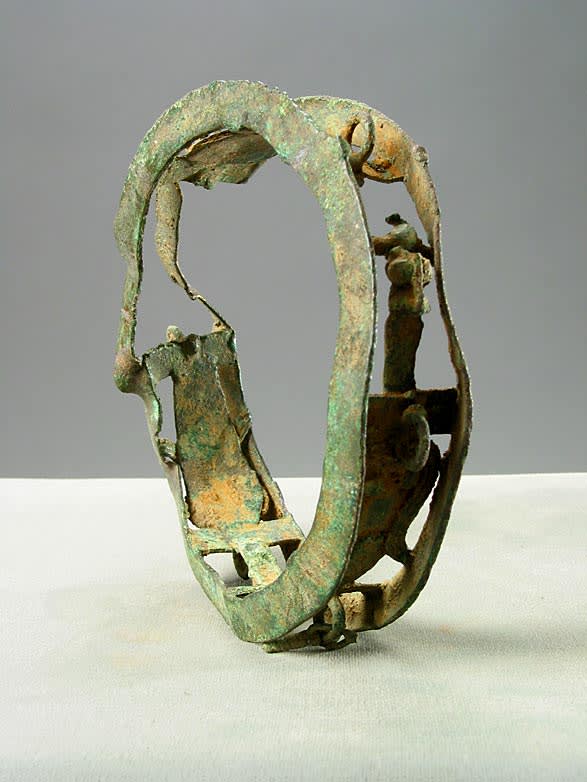Djenne Bronze Bracelet, 13th Century CE - 16th Century CE
Copper Alloy
PF.9941 (LSO)
Further images
This dynamic bracelet was made the Djenne people of Mali. It is a double-band of metal, connected with strapwork and decorative motifs in abstract and zoomorphic (?) forms. The piece...
This dynamic bracelet was made the Djenne people of Mali. It is a double-band of metal, connected with strapwork and decorative motifs in abstract and zoomorphic (?) forms. The piece is furnished with eyelets for suspension and perhaps the addition of other objects.
The Djenne culture is focused upon the historic city of Djenne-Djenno in the Niger Inland Delta of modern Mali. It is the oldest city in Sub-Saharan Africa, and the onetime hub of an enormous trading empire during the Middle Ages. It was founded by the Bozo (allied with the Bamana) people in about 800 AD, and gained its wealth by taking advantage of Trans-Saharan trade networks. The Djenne style is technically part of the Malian Empire – along with numerous other groups (i.e. the Tenenku, Bura and Bankoni [centred on the town of Bamako]) – but the city itself never was. Indeed, the Malian Empire is said to have tried to conquer the city-state 99 times before giving up.
Djenne culture – and that of the closely allied Bankoni group – is highly significant in the development of West African art styles. They had a great influence on the artistic repertoire of later groups, notably the Dogon. Their central preoccupation was seated, standing and kneeling human figures, in addition to equestrian and zoomorphic/anthropomorphic divertimenti. They are invariably highly expressionistic, with little regard for proportion and scale, but with phenomenal modelling to produce powerful and refined masterworks such as this example. Owing to the popularity of Djenne pieces, sites have been systematically plundered so we know almost nothing of their culture beyond its evident refinement. It was evidently highly socially stratified, with major markers of wealth including scarifications, jewellery, horses and prestige artefacts such as the sculptures themselves.
This would have been a major marker of status in Djenne society. It is a rare and important piece of African art.
The Djenne culture is focused upon the historic city of Djenne-Djenno in the Niger Inland Delta of modern Mali. It is the oldest city in Sub-Saharan Africa, and the onetime hub of an enormous trading empire during the Middle Ages. It was founded by the Bozo (allied with the Bamana) people in about 800 AD, and gained its wealth by taking advantage of Trans-Saharan trade networks. The Djenne style is technically part of the Malian Empire – along with numerous other groups (i.e. the Tenenku, Bura and Bankoni [centred on the town of Bamako]) – but the city itself never was. Indeed, the Malian Empire is said to have tried to conquer the city-state 99 times before giving up.
Djenne culture – and that of the closely allied Bankoni group – is highly significant in the development of West African art styles. They had a great influence on the artistic repertoire of later groups, notably the Dogon. Their central preoccupation was seated, standing and kneeling human figures, in addition to equestrian and zoomorphic/anthropomorphic divertimenti. They are invariably highly expressionistic, with little regard for proportion and scale, but with phenomenal modelling to produce powerful and refined masterworks such as this example. Owing to the popularity of Djenne pieces, sites have been systematically plundered so we know almost nothing of their culture beyond its evident refinement. It was evidently highly socially stratified, with major markers of wealth including scarifications, jewellery, horses and prestige artefacts such as the sculptures themselves.
This would have been a major marker of status in Djenne society. It is a rare and important piece of African art.





